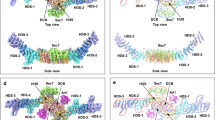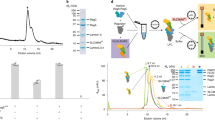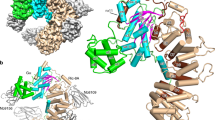Abstract
Small G proteins switch from a resting, GDP-bound state to an active, GTP-bound state. As spontaneous GDP release is slow, guanine-nucleotide-exchange factors (GEFs) are required to promote fast activation of small G proteins through replacement of GDP with GTP in vivo1. Families of GEFs with no sequence similarity to other GEF families have now been assigned to most families of small G proteins. In the case of the small G protein Arf1, the exchange of bound GDP for GTP promotes the coating of secretory vesicles in Golgi traffic2. An exchange factor for human Arf1, ARNO3, and two closely related proteins, named cytohesin 1 (ref. 4) and GPS1 (ref. 5), have been identified. These three proteins are modular proteins with an amino-terminal coiled-coil, a central Sec7-like domain and a carboxy-terminal pleckstrin homology domain. The Sec7 domain contains the exchange-factor activity3. It was first found in Sec7, a yeast protein involved in secretion6, and is present in several other proteins, including the yeast exchange factors for Arf, Gea1 and Gea2 (7–9). Here we report the crystal structure of the Sec7 domain of human ARNO at 2 Å resolution and the identification of the site of interaction of ARNO with Arf.
This is a preview of subscription content, access via your institution
Access options
Subscribe to this journal
Receive 51 print issues and online access
$199.00 per year
only $3.90 per issue
Buy this article
- Purchase on Springer Link
- Instant access to full article PDF
Prices may be subject to local taxes which are calculated during checkout




Similar content being viewed by others
References
Quilliam, L. A., Khosravi-Far, R., Huff, S. Y., Solski, P. A. & Der, C. J. Guanine nucleotide exchange factors: activators of the Ras superfamily of proteins. Bioessays 17, 395–404 (1995).
Scheckman, R. & Orci, L. Coat proteins and vesicle budding. Science 271, 1526–1533 (1996).
Chardin, P. et al. Ahuman exchange factor for ARF contains Sec7- and pleckstrin-homology domains. Nature 384, 481–484 (1996).
Meacci, E., Tsai, S. C., Adamik, R., Moss, J. & Vaughan, M. Cytohesin-1, a cytosolic guanine nucleotide-exchange protein for ADP-ribosylation factor. Proc. Natl Acad. Sci. 94, 1745–1748 (1997).
Klarlund, J. K. et al. Signaling by phosphoinositide-3,4,5-trisphosphate through proteins containing pleckstrin and Sec7 homology domains. Science 275, 1927–1930 (1997).
Novick, P., Ferro, S. & Schekman, R. Orders of events in the yeast secretory pathway. Cell 25, 461–469 (1981).
Peyroche, A., Paris, S. & Jackson, C. L. Nucleotide exchange on ARF mediated by yeast Gea1 protein. Nature 384, 479–481 (1996).
Shevell, D. E. et al. EMB30 is essential for normal cell division, cell expansion, and cell adhesion in Arabidopsis and encodes a protein that has similarity to Sec7. Cell 77, 1051–1062 (1994).
Morinaga, N., Moss, J. & Vaughan, M. Cloning and expression of a cDNA encoding a bovine brain brefeldin A-sensitive guanine nucleotide-exchange protein for ADP-ribosylation factor. Proc. Natl Acad. Sci. USA 94, 12926–12931 (1997).
Huber, A. H., Nelson, J. & Wies, W. I. Three-dimensional structure of the Armadillo repeat of β-catenin. Cell 90, 871–882 (1997).
Kawashima, T., Berthet-Colominas, C., Wulff, M., Cusack, S. & Leberman, R. The structure of the Escherichia coli EF-Tu.EF-Ts complex at 2.5 Å resolution. Nature 379, 511–518 (1996).
Wang, Y., Jiang, Y., Meyering-Voss, M., Sprintzl, M. & Sigler, P. Crystal structure of the EF-Tu.EF-Ts complex from Thermus thermophilus. Nature Struct. Biol. 4, 650–656 (1997).
Yu, H. & Schreiber, S. L. Structure of guanine-nucleotide-exchange factor human Mss4 and identification of its Rab-interacting surface. Nature 376, 788–791 (1995).
Harrison, C. J., Hayer-Hartl, M., Di Liberto, M., Hartl, F. U. & Kuriyan, J. Crystal structure of the nucleotide exchange factor GrpE bound to the ATPase domain of the molecular chaperone DnaK. Science 276, 431–435 (1997).
Renault, L. et al. The 1.7 Å crystal structure of the regulator of chromosome condensation (RCC1) reveals a seven-bladed propeller. Nature 392, 97–101 (1998).
Scheffzek, K. et al. The ras-rasGAP complex: structural basis for GTPase activation and its loss in oncogenic mutants. Science 277, 333–338 (1997).
Rittinger, K., Walker, P. A., Eccleston, J. F., Smerdon, S. J. & Gamblin, S. J. Structure at 1.65 Å of RhoA and its GTPasep-activating protein in complex with a transition-state analog. Nature 389, 758–762 (1997).
Paris, S. et al. Role of protein-phospholipid interactions in the activation of ARF1 by the guanine nucleotide exchange factor Arno. J. Biol. Chem. 272, 22221–22226 (1997).
Jacquet, E., Baouz, S. & Parmeggiani, A. Characterization of a mammalian C-CDC25Mm exchange factor and kinetic properties of the exchange reaction intermediate p21.C-CDC25Mm. Biochemistry 34, 12347–12354 (1995).
Verroti, A. C. et al. RAS residues that are distant form the GDP binding site play a critical role in dissociation factor-stimulated release of GDP. EMBO J. 11, 2855–2862 (1992).
Segal, M., Willumsen, B. & Levitzk, A. Residues crucial for Ras interaction with GDP-GTP exchangers. Proc. Natl Acad. Sci. USA 90, 5564–5568 (1993).
Antonny, B., Béraud-Dufour, S., Chardin, P. & Chabre, M. N-terminal hydrophobic residues of the G-protein ADP-ribosylation factor-1 insert into membrane phospholipids upon GDP to GTP exchange. Biochemistry 36, 4675–4684 (1997).
Schimmöller, F., Itin, C. & Pfeffer, S. Vesicle traffic: get your coat! Curr. Biol. 7, R235–R237 (1997).
Amor, J. C., Harrison, D. H., Kahn, R. A. & Ringe, D. Structure of the human ADP-ribosylation factor 1 complexed with GDP. Nature 372, 704–708 (1994).
Madej, T., Gibrat, J. F. & Bryant, S. H. Threading a database of protein cores. Proteins Struct. Funct. Genet. 23, 356–369 (1995).
Schalk, I. et al. Structure and mutational analysis of Rab GDP-dissociation inhibitor. Nature 381, 42–48 (1996).
Keep, N. H. et al. Amodulator of rho family G proteins, rhoGDI, binds these G proteins via an immunoglobulin-like domain and a flexible N-terminal arm. Structure 5, 623–633 (1997).
Kolanus, W. et al. αLβ2 integrin/LFA-1 binding to ICAM-1 induced by cytohesin-1, a cytoplasmic regulatory molecule. Cell 86, 233–242 (1996).
Collaborative Computational Project No. 4. The CCP4 suite: programs for protein crystallography. Acta Crystallogr. D 50, 760–763 (1994).
De la Fortelle, E. & Bricogne, G. Maximum-likeliwood heavy-atom parameter refinement for multiple isomorphous replacement and multiwavelength anomalous diffraction methods. Methods Enzymol. 276, 472–494 (1997).
Acknowledgements
We thank the staff at the LURE for making outstation W32 available to us; M. Roth at the ESRF for beamlight assistance at outstation D2AM; S. Bryant and T. Madej for the Protein Data Bank survey with VAST; J.-F. Gibrat for sequence-threading calculations; S. Paris for unpublished observations; and M. Chabre and J. Janin for discussions. This work was supported by the Association pour la Recherche contre le Cancer and by Zénéca Pharma (France). M.M. was supported by an EMBO fellowship.
Author information
Authors and Affiliations
Corresponding author
Rights and permissions
About this article
Cite this article
Cherfils, J., Ménétrey, J., Mathieu, M. et al. Structure of the Sec7 domain of the Arf exchange factor ARNO. Nature 392, 101–105 (1998). https://doi.org/10.1038/32210
Received:
Accepted:
Issue Date:
DOI: https://doi.org/10.1038/32210
This article is cited by
-
Brefeldin A-inhibited guanine nucleotide-exchange protein 3 (BIG3) is predicted to interact with its partner through an ARM-type α-helical structure
BMC Research Notes (2014)
-
Regulating the large Sec7 ARF guanine nucleotide exchange factors: the when, where and how of activation
Cellular and Molecular Life Sciences (2014)
-
Solution structure of subunit a, a 104-363, of the Saccharomyces cerevisiae V-ATPase and the importance of its C-terminus in structure formation
Journal of Bioenergetics and Biomembranes (2012)
-
Arf1
AfCS-Nature Molecule Pages (2005)
-
Structural snapshots of the mechanism and inhibition of a guanine nucleotide exchange factor
Nature (2003)
Comments
By submitting a comment you agree to abide by our Terms and Community Guidelines. If you find something abusive or that does not comply with our terms or guidelines please flag it as inappropriate.



